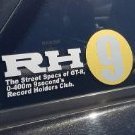R34 Gtr Build
Announcements
-
Similar Content
-
Latest Posts
-
I've got 15 year old tyres on a car in my garage, holding air (holding it better than the daily driver does!) and no signs of rotting/cracking/drying out. Oh, and they've only been garaged the last 3. Before that they sat in a couple of different paddocks/yards, and even spent about a week underwater too. However, weather and other environmental factors can really change how quickly they start to dry out and crack.
-
The moment I read "never brought in the 1 child policy like China" I was ready to send a reply "it's what they use the second child in china for..." Ha ha ha I can tell how quickly your brain squirrels 😛
-
By joshuaho96 · Posted
10 years is really pushing it. At 7-8 years you need to inspect frequently for signs of dry rot.
-






Recommended Posts
Create an account or sign in to comment
You need to be a member in order to leave a comment
Create an account
Sign up for a new account in our community. It's easy!
Register a new accountSign in
Already have an account? Sign in here.
Sign In Now